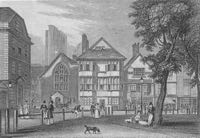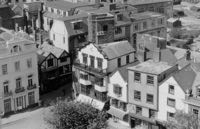
- Home
- Memories
- Scrapbook ▽
- Topics ▽
- People ▽
- Events
- Photos
- Site Map
- Timeline
Page updated 16th September 2018
Many guide books to Exeter refer to Mol's as a coffee house opened by an Italian called Mol in the 16th century. In addition, they often state that Elizabethan seafarers such as Drake, Raleigh and Hawkins met to discuss their victory over the Armada, in the upper oak lined room of Mol's. However, new academic research has shown that much of the history of this building was concocted by a Mr Worth, who ran a gallery from the premises in the late 19th and early 20th century.
So what is the true history of Mol's Coffee House?
The building, along with Hanson's, next door, was built by the Cathedral Authorities to house 'Annuellars', or priests. Annuellars attended to the last wishes of benefactors to the Cathedral. They would conduct duties requested by the deceased, visit and comfort relatives and keep a candle lit in remembrance. It was during the Reformation of the 1540's that these practices were banned and the buildings housing the priests were taken over for other purposes. At this time numbers 1-5 Cathedral Close were part of the Annuellars College.
The various buildings of the College were sublet after the Reformation and the tenants undertook, over the years, various modifications.
It was in 1585 that a yeoman of the city, John Dyer took out a lease on the building. In November 1588, Dyer became involved in negotiations with the government over the payment of the city's contribution for ships for the Armada, and it was at Mol's that the negotiations were conducted. It has been long thought that Exeter was rewarded for her efforts in helping the Queen, by Elizabeth bestowing the city motto Semper Fidelis. However, recent research by Dr Todd Gray of Exeter University has revealed that there is no record of Elizabeth writing such a phrase. It was bestowed by Charles II for the loyalty the city gave after he was restored to the throne.
Exeter in fact supplied one ship while Topsham supplied and equipped three ships The Rose, The Gift and The Bartholomew against the Armada.
The Royal Coat of Arms over the front of Mol's was put in place, by Dyer in 1596. It was at this time that the ground floor was leased for use as a customs house and it is probable that Dyer wished to indicate this official function. The building remained in use as a Custom House until 1660, when the function was probably moved to Topsham, before the new Custom House was built on the quay in 1680.
The year after the Custom House moved out, in 1661, saw Mols converted into an apothecary shop, and a year later a shoe shop. It was noted as a haberdashery in 1715.
It was in the year 1726 that an advert appeared in December's Brices' Weekly Journal with the name of Mol's - a Mary Wildy had leased the building in the previous June. And what of the name Mol's - was this the mysterious Italian of myth. The more likely truth is that Mol's is derived from Mol or Molly, which were shortened versions of Mary.
For the next hundred or so years, the coffee house was run by seven women, providing a quiet meeting and reading place for the gentlemen of Exeter. Some of the owners would act as a ticket office for concerts at The Hotel (Royal Clarence), and as a place to subscribe to public appeals. The proprietors can be listed thus:
1726 - 1752 Mary Wildy
(circa 1752)
1752 - 1787 Margaret Wildier
1787 - 1789 Mrs Vinnicombe. Died 5 November 1789.
1789 - 1792 Mary Murch. Died November 1792.
1793 - 1817 Miss Sarah Hurd (Heard) Died 21 May 1817, aged 77.
1820 - 1832 Mrs Mary Commins - moved business to 253 High St (Flying
Post in 1882 stated the coffee house closed in 1829)
The church used its authority to control much that went on in properties that they leased. Mols were leaned on in 1819, when the Chapter clerk of the Cathedral informed the lessee of Mol's that they objected to the premises being open during Divine Services on Sundays, Christmas Day and Good Friday, and that they were to be closed at these times.
During the first part of the 19th century other institutions opened such as the Public Select Library in 1807 and the Devon & Exeter Institution in 1814, giving gentlemen alternative places to catch up on the news stories of the day. The demise of Mol's Coffee House was inevitable and it closed in 1837.
It was in 1833 that Mol's became the centre for art and a leading gallery in Exeter. The Exeter born artist, John Gendall moved into the premises as a teacher, an illustrator and carriage painter, as well as running drawing classes in Cathedral Close. He lived there with his wife Maria, and in 1861 was employing 7 men and 4 boys in his business as landscape painter, carver and gilder. He also acted as an agent for the County Fire Office and Provident Life Office, probably to supplement his income from his main business, in the first few years of his occupancy of Mol's.
His documenting of Exeter during this time is unparalleled and much of what we know of the buildings of Exeter in the 19th century is due to his illustrations and paintings. It is John Gendall who is said to have painted the 46 Devonshire family coats of arms that line the first floor, oak panelled room. Gendall died in 1865 and Mol's was taken over by Henry Hodge, 'bookbinders, stationers and gilders'.
The next occupier of Mol's was Thomas Burnett Worth (1827-93) of Worth's Gallery who moved in during 1878. He ran a highly successful business, printing postcards, guidebooks and other material about Exeter. It is Worth's efforts to promote his business for the growing tourist trade that led to many of the myths associated with Mol's and the Ship Inn. He is also attributed with adding the third story, Dutch style gable to the building in 1879. There are over 230 panes of glass in the Tudor and Dutch style windows, none of which are square. Picture framing was done on this third floor and it was said that due to the narrow stairs, large pictures had to be lowered through holes in the floor with rope and pulleys. After his death, the business was continued by his son, also known as Thomas Burnett Worth. Worth's closed in 1958 and was replaced by the Fred Keetch Gallery.
Nottingham and Walsh, the jewellers were the next to occupy the premises from about 1987 and then the old Exeter stationers and map dealers, Elands moved from Bedford Street into Mol's. They seemed set to last for ever in this old building, and were a perfect fit in the corner of Cathedral Close, but they too closed in 2007. The present occupier is The Collection, a high-class boutique that sells designer gifts from Mont Blanc pens to handmade leather goods.
The fire that destroyed the Royal Clarence Hotel on Friday 28 October 2016, threatened to jump the gap to St Martin's Church. If it had done so, the fire would have spread to Mol's and the other ancient buildings in the Close. The occupants of the Close were advised to evacuate, and St Martin's and Mol's were covered in foam. In the event, the efforts of the fire fighters, stopped the fire spreading, and the buildings along the glorious Cathedral Close were saved for us all to enjoy.
Source - Exeter Unveiled by Todd Gray (an excellent account of Mol's plus other fascinating history of Exeter). British Newspaper Archive, the Exeter Cathedral archives.

19th Century print showing the original upper floor and roof before Thomas Brnett Worth rebuilt it in 1879.

Photo taken by Henry Holladay from the Cathedral, just after the war. Part of the damaged High Street can be seen top right. Photo courtesy of Richard Holladay
│ Top of Page │